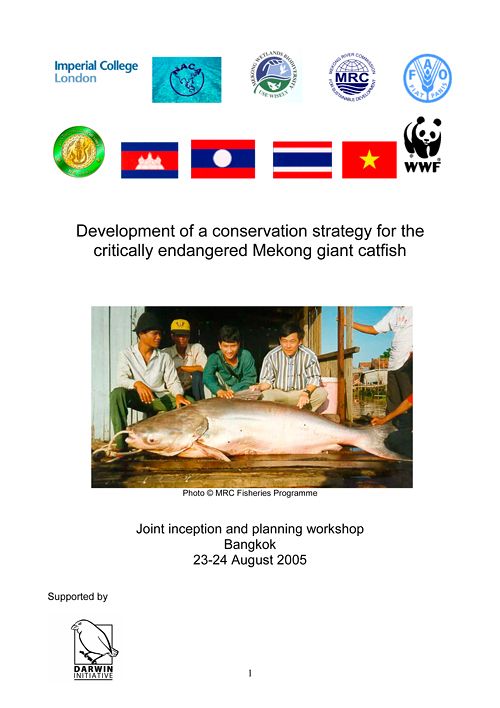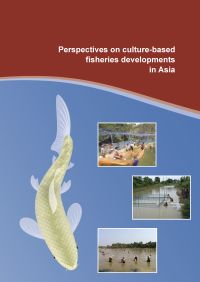Development of a conservation strategy for the critically endangered Mekong giant catfish: Joint inception and planning workshop
24 August 2005 | 878 Downloads | .pdf | 649.14 KB | Cambodia, Freshwater finfish, Genetics and Biodiversity, Lao PDR, Thailand, Vietnam
The Mekong giant catfish Pangasianodon gigas is one of the world’s largest freshwater fish, and a charismatic animal revered throughout the lower Mekong region. The species is listed as critically endangered in the 2003 IUCN Red List.
A range of conservation initiatives for the Mekong giant catfish are being carried out by organisations including the fisheries departments of Cambodia, Laos and Thailand, the Mekong River Commission, the UNDP/IUCN/MRC Mekong Wetlands Biodiversity Project, the Network of Aquaculture Centers in Asia-Pacific, WWF Indochina, and Imperial College London. A joint conservation strategy workshop was held at NACA, Bangkok, 23-24 August 2005. The purpose of the workshop was to exchange information on the current state of the Mekong giant catfish and the relevant conservation and research activities of key organisations, and to establish a joint planning process aimed at developing an overarching conservation strategy for the Mekong giant catfish.
The status of the wild population remains somewhat uncertain. Recorded catches have declined dramatically over the past 20 years, and it is on this basis that the population has been designated as critically endangered. Fishing pressure is perceived as the most important reason for past population decline. There remain substantial uncertainties however with regards to trends in fishing effort and the level of catches of juveniles and early life stages (which are not easily distinguished from the more abundant river catfish P. hypophthalmus). There is a large captive population of about 20,000 individuals derived almost entirely from wild parents. This captive population will be a major resource for species conservation if it is managed appropriately. Habitats are only moderately degraded at present, but plans for hydropower and navigation development may pose significant threats in the future.
Current conservation measures focus on the reduction of incidental fishing mortality through a buy-and-release scheme in Cambodia, and a well established captive breeding programme in Thailand. Various initiatives aimed at conserving Mekong habitats and the wider ecosystems, while not focused on the giant catfish as such, often make reference to it as a flagship species. An initial appraisal of these conservation measures suggests that reduction in fishing mortality through buyand- release is potentially effective and relatively cheap, but remains a short-term measure. The captive breeding programme is provides a crucial ‘insurance’ for species survival if, as seems likely, the wild population continues to decline. The release of captive bred or commercially cultured giant catfish may, however, pose a further threat to wild population viability if inadequately managed. Habitat and ecosystem conservation are important to safeguarding the long-term survival of the population, even though habitat degradation is unlikely to have played a major role in the historical decline of the species.
It was noted that both the current status of the wild population and the effectiveness of current and possible future conservation measures are poorly known. Focused research is urgently required to provide a basis for the development of an effective conservation strategy. The key research priorities identified are: (a) quantitative assessment of the status of the wild population and the reasons for its apparent decline; (b) quantitative assessment of the likely effectiveness of different conservation measures including harvest reductions, supportive breeding/re-introduction, and habitat conservation; (c) development of genetic and demographic management strategies for the captive population; (d) quantification of harvest and fishing mortality of juveniles; (e) identification of migration routes and critical habitat for different life stages; (f) development of improved handling protocols to maximise survival of fish released after capture; and (g) economic evaluation of conservation measures.
An overarching, basin-wide conservation strategy for the Mekong giant catfish should be developed in order to maximise the effectiveness of conservation measures. This strategy should be based on better information exchange and coordination of activities conducted by different organisations; effective use of research to resolve key uncertainties, and effective engagement of conservation planning with regional, national and local policy processes. The organisations represented at the workshop agree to institute a joint conservation planning process built around these requirements. At the core of the process will be a series of joint workshops, interspersed with specific research, policy and outreach activities by contributing organisations.
Key future workshops in the conservation strategy planning process are a species conservation action plan (SCAP) workshop in Phnom Penh, December 2005; a quantitative assessment workshop in Vientiane, August 2006, and a conservation strategy workshop in Bangkok, December 2006.
Creative Commons Attribution.

